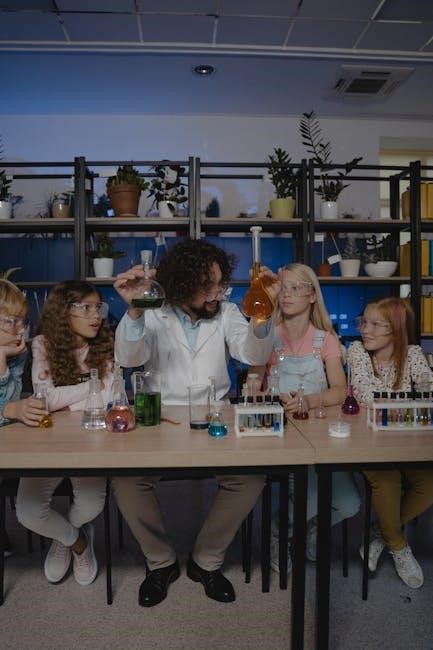
Lessons in Chemistry explores mature themes, including a graphic rape scene, brief sex scenes, and references to sex, set in the 1950s. Violence and emotional intensity are present, making it suitable for mature audiences, including teenagers with parental guidance.

Content Rating and Suitability
Lessons in Chemistry is rated as a series with moderate to mature content, making it unsuitable for young children. While it primarily targets adult audiences, mature teenagers may find it appropriate if they have been exposed to similar themes in other media. The show blends science, romance, and historical drama, set in the 1950s, but it tackles complex and sensitive topics. Parents should be aware of its mature themes, including brief sexual content, references to violence, and emotional intensity. The series has been praised for its intellectual depth and strong female lead but contains scenes that may require parental discretion. Overall, it is recommended for viewers aged 16 and above, depending on individual sensitivity and maturity levels. The series is a great opportunity for discussions about gender roles, STEM education, and societal challenges, but younger audiences may need guidance to fully understand and process its content.
Sex and Nudity in the Series
The series Lessons in Chemistry contains scenes of sex and nudity, which are brief but present. These include a graphic rape scene that is a pivotal moment in the storyline, as well as references to sexual content in conversations. There are also instances of nudity, such as a female character breastfeeding and a male character’s buttocks being shown in a shower scene. While these elements are not overly explicit, they are noticeable and may require parental discretion. The show does not shy away from depicting sexual themes, but they are often framed within the context of the storyline and character development. Parents should be aware of these scenes, especially when considering younger or more sensitive viewers. The series balances these mature elements with its focus on science, gender equality, and personal growth, making it a complex but thought-provoking watch.

Violence and Gore Content
The series Lessons in Chemistry includes scenes of violence and some intense moments that may concern parents. A notable scene involves a graphic rape attempt, where the main character, Elizabeth Zott, defends herself by stabbing her attacker with a pencil. This moment is pivotal to the storyline but may be distressing for some viewers. Additionally, there are references to violence against women and societal oppression, reflecting the challenges faced by women in the 1950s. While the show does not focus excessively on gore, the emotional intensity of certain scenes, such as the death of a loved one and its impact on Elizabeth and her daughter, can be unsettling. These elements are portrayed to highlight the resilience and strength of the characters rather than for shock value. Parents should be aware of these scenes when deciding if the series is appropriate for their children. The violence is not gratuitous but serves to underscore the broader themes of struggle and empowerment in the story. However, sensitive viewers may find some moments emotionally challenging.
Profanity and Language Used
The language in Lessons in Chemistry is generally moderate, reflecting the 1950s setting and the professional backdrop of its characters. While the series does not rely heavily on profanity, there are instances where strong language is used to convey emotional intensity or frustration. Elizabeth Zott, the protagonist, occasionally uses sharp, assertive language when facing discrimination or challenging situations, showcasing her strength and determination. Some scenes include mild swearing, particularly in moments of conflict or when characters are under stress. However, the overall tone remains more refined and less explicit compared to modern-day standards. Parents should be aware that while the language is not excessive, it may still prompt discussions about the appropriateness of certain words in different contexts. The series uses language thoughtfully, often to highlight character development or the societal norms of the era, rather than for shock value. This balance makes it suitable for older teenagers, though parental discretion is advised for younger or more sensitive viewers.
Alcohol, Drugs, and Smoking Scenes
The portrayal of alcohol, drugs, and smoking in Lessons in Chemistry is moderate and contextually appropriate to its 1950s setting. Alcohol consumption is depicted in social and professional settings, often reflecting the norms of the time. Characters are occasionally shown drinking at parties or in casual gatherings, but excessive or problematic behavior is not a focal point. Smoking is also present, with some characters smoking cigarettes, which was common during the era. However, the series does not glorify or emphasize substance use; instead, it uses these elements to add authenticity to the period and characters. There are no significant scenes involving illegal drugs, and the overall narrative does not promote or dwell on substance use. Parents should be aware of these elements but note that they are not central to the storyline. The series’ focus remains on themes like gender equality and scientific exploration, making it suitable for older teenagers with parental guidance. The moderate inclusion of alcohol and smoking serves to enhance the show’s historical accuracy rather than to influence viewer behavior.

Frightening and Intense Scenes
Lessons in Chemistry contains some frightening and intense scenes that may not be suitable for all audiences. One of the most distressing moments is a graphic rape scene, which, while brief, is deeply unsettling and could be triggering for some viewers. Additionally, the series explores themes of emotional struggle, including the protagonist’s fight against systemic sexism and personal loss, which can be emotionally intense for viewers, especially teenagers. There are also scenes of confrontation and tension that contribute to the show’s dramatic tone. However, the series avoids excessive gore or prolonged distress, balancing intense moments with a focus on character growth and resilience. Parents should be aware of these scenes and use discretion when allowing younger or sensitive viewers to watch. The show’s thoughtful handling of intense content makes it a valuable but potentially challenging watch for mature audiences. Overall, the frightening and intense scenes are impactful but not gratuitous, serving to underscore the story’s emotional depth and historical context.

Key Themes for Parental Awareness
Lessons in Chemistry tackles several key themes that are important for parents to be aware of when deciding if the show is appropriate for their children. The series delves into issues of gender inequality and sexism, particularly in the context of a male-dominated scientific field in the 1950s. The protagonist, Elizabeth Zott, faces significant challenges due to her gender, which can spark important conversations about feminism and equality. Additionally, the show addresses themes of single parenthood and the societal pressures faced by single mothers; It also touches on the emotional and psychological impacts of personal loss and resilience. While these themes are thought-provoking and meaningful, they may require parental guidance to help younger viewers fully understand and process the complexities. The show’s focus on STEM education and scientific inquiry is another positive theme, encouraging curiosity and critical thinking. Overall, the series presents a mix of challenging and uplifting themes that can foster valuable discussions between parents and teenagers. However, the maturity of some content means parental discretion is advised.

Historical Context and Gender Roles
Lessons in Chemistry is set in the 1950s, a time when gender roles were rigidly defined, and women faced significant barriers in male-dominated fields like science. The series highlights the challenges faced by its protagonist, Elizabeth Zott, a brilliant female chemist navigating a patriarchal world. Her journey underscores the systemic sexism and gender bias prevalent during that era, offering a stark reminder of how far women have come—and how much work remains. The show also explores the societal expectations placed on women, particularly in balancing careers and family life. Elizabeth’s role as a single mother adds another layer of complexity, as she confronts the stigma and judgment associated with raising a child alone in a conservative society. The historical context is crucial for understanding the character’s motivations and the obstacles she faces. By portraying these struggles, the series provides a powerful commentary on gender equality and the resilience of women in the face of adversity. This makes it a valuable tool for discussing historical gender roles and their ongoing impact with teenagers. The show’s portrayal of these issues is both informative and thought-provoking, offering lessons that remain relevant today.
STEM Education and Scientific Concepts
Lessons in Chemistry shines in its portrayal of STEM education and scientific concepts, blending chemistry with everyday life in an engaging and accessible way. The series follows Elizabeth Zott, a brilliant chemist, as she explains complex scientific ideas through cooking, making science relatable and fun. This unique approach highlights the practical applications of chemistry, encouraging viewers to think critically about the science behind mundane tasks. The show also delves into themes like abiogenesis, showcasing the beauty and complexity of scientific inquiry. By integrating STEM concepts into the storyline, the series sparks curiosity and interest in science, particularly among young audiences. The historical context of a female scientist in the 1950s adds depth, emphasizing the challenges women faced in STEM fields and inspiring conversations about gender equality in science. The series’ ability to make science appealing and understandable makes it a valuable resource for fostering an interest in STEM subjects among teenagers. Its blend of education and entertainment creates a compelling narrative that can motivate viewers to explore scientific careers. This aspect of the show is both educational and inspiring, making it a standout element for parents and educators.
Parental Guidance and Viewing Recommendations
Parents are advised to exercise discretion when allowing their children to watch Lessons in Chemistry, as the series contains mature themes and content. While the show is rated as moderate to mature, it is not suitable for young children due to its graphic rape scene, brief sex scenes, and references to sex. However, for teenagers aged 16 and above, the series can be appropriate if viewed with parental guidance, especially if they have been exposed to similar R-rated content. The show tackles serious issues like sexual violence, death, and gender inequality, which can spark important conversations between parents and teens. Additionally, the series promotes STEM education and critical thinking, making it a valuable watch for older adolescents. Parents are encouraged to preview the content and watch the series with their teenagers to provide context and address any questions or concerns. This approach fosters a deeper understanding of the themes and helps teens navigate the complex emotions and scenarios portrayed in the show. Overall, Lessons in Chemistry is a thought-provoking series that, with proper guidance, can be a meaningful viewing experience for mature audiences.

